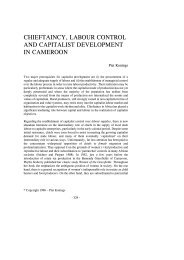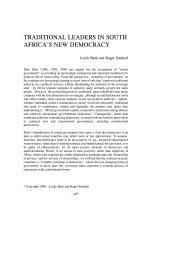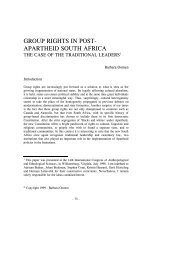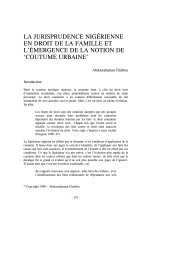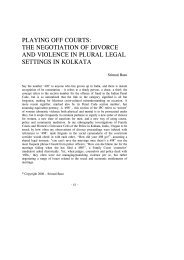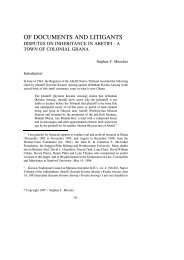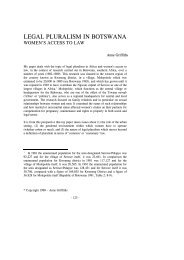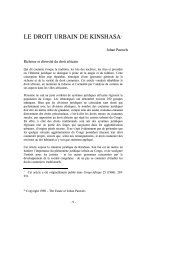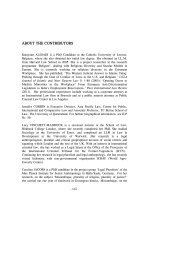review (pdf) - Journal of Legal Pluralism
review (pdf) - Journal of Legal Pluralism
review (pdf) - Journal of Legal Pluralism
Create successful ePaper yourself
Turn your PDF publications into a flip-book with our unique Google optimized e-Paper software.
BOOK REVIEW<br />
Ralph Grillo, Roger Ballard, Alessandro Ferrari André J. Hoekema, Marcel<br />
Maussen and Prakash Shah (eds.), <strong>Legal</strong> Practice and Cultural Diversity. Farnham<br />
UK and Burlington VT: Ashgate. 2009.<br />
Amy Jackson<br />
The editors assembled the chapters <strong>of</strong> this collection from papers based on those<br />
presented at a conference hosted by the Law School, Queen Mary, University <strong>of</strong><br />
London in July 2007. The conference was sponsored by the multi-disciplinary<br />
research programme International Migration, Integration and Social Cohesion,<br />
(IMISCOE) which is a ‘network <strong>of</strong> excellence’ funded by the European<br />
Commission. One <strong>of</strong> the principal aims <strong>of</strong> IMISCOE is to provide a platform for<br />
the exchange <strong>of</strong> innovative ideas related to issues <strong>of</strong> migration. Due to the<br />
emphasis on the exchange <strong>of</strong> ideas, in comparison to previous collections on law<br />
and cultural diversity, such as human rights and culture through anthropological<br />
perspectives (Cowan et al. 2001) or immigration in the European context (Shah<br />
and Menski 2006), the present collection contributes both a comparative and a<br />
theoretical account <strong>of</strong> the interaction between legal practice and cultural diversity<br />
from a range <strong>of</strong> leading international anthropologists, political scientists and legal<br />
specialists.<br />
The collection opens with the Archbishop <strong>of</strong> Canterbury’s statement that scholars<br />
and practitioners should consider “the role and rule <strong>of</strong> law in a plural society <strong>of</strong><br />
overlapping identities (Williams 2008: 271). The Archbishop made the statement<br />
during his comments in February 2008 when he suggested debating the<br />
“transformative accommodation” (Shachar 2001) <strong>of</strong> shari’a councils in the English<br />
legal system. His comments were heavily criticised by scholars (Ahmed 2008:<br />
495; Bano 2008). The use <strong>of</strong> the Archbishop’s statement contextualises the<br />
contentious nature <strong>of</strong> the discussions throughout the collection related to whether,<br />
and under what conditions, legal systems should acknowledge cultural and<br />
religious differences (2). The collection accordingly raises important questions<br />
related to<br />
- 149 -
JOURNAL OF LEGAL PLURALISM<br />
2009 – nr. 59<br />
___________________________________________________________________<br />
how contemporary cultural and religious diversity challenges<br />
legal practice, how legal practice responds to that challenge and<br />
how practice is changing in the encounter with cultural diversity<br />
occasioned by large-scale, post-war immigration” (1).<br />
The objective is to consider how legal practice should respond to cultural diversity<br />
as both change and challenge the other in various ways. The insights <strong>of</strong> the<br />
collection are beneficial to legal scholars and practitioners for two reasons. It will<br />
enable them, first, to gain comparative insights from the experiences and debates<br />
surrounding cultural diversity other jurisdictions, and secondly, to understand the<br />
theoretical insights that legal pluralism may add to this field <strong>of</strong> study.<br />
In relation to the comparative insights presented in the collection, several chapters<br />
reveal valuable perspectives from the experiences <strong>of</strong> cultural diversity in an array<br />
<strong>of</strong> jurisdictions. Several authors stress the particular context <strong>of</strong> each situation. It is<br />
still beneficial, however, for legal scholars and practitioners to pose questions<br />
about possible comparisons <strong>of</strong> such experiences and debates. For example,<br />
although India is a formerly colonised country with a historical tradition <strong>of</strong><br />
religious plurality, what could be learned from the Indian notion <strong>of</strong> secularism as<br />
equality <strong>of</strong> religious pluralism rather than the division <strong>of</strong> religion from the realm<br />
<strong>of</strong> the state (Menski)? What potential lessons could be learned from the debate in<br />
Ontario, Canada related to establishing a Darul-Qada, Muslim Arbitration<br />
Tribunal (Bader)? Although Québec holds a particular historical and geopolitical<br />
position as a linguistic minority in Canada, what could be learned from the debate<br />
related to the doctrine <strong>of</strong> ‘reasonable accommodation’ and the recommendations <strong>of</strong><br />
the report by the Bouchard-Taylor Commission (Gaudreault-DesBiens)? The Dutch<br />
constitution places importance on the separation <strong>of</strong> law from religion, but what<br />
could be drawn out from the judicial behaviour which recognises the laws <strong>of</strong><br />
‘distinct’ communities and consequently pluralizes law (Hoekema)? What insights<br />
can be gained from a comparative study <strong>of</strong> North American and European civil<br />
cases and the possibility <strong>of</strong> higher damages being awarded to claimants based on<br />
their cultural backgrounds (Renteln)? Finally, what could be learned from the<br />
French debate surrounding laïcité and multiculturalism, bearing in mind that the<br />
French experience strongly differs from that <strong>of</strong> other European countries (Cohen)?<br />
<strong>Legal</strong> scholars and practitioners may also benefit from considering the innovative<br />
approaches <strong>of</strong> English legal practice to other situations <strong>of</strong> cultural diversity. For<br />
example, lessons can be learned from the English legal culture’s treatment <strong>of</strong><br />
minority ethnic settlers in other contexts such as African customary laws<br />
- 150 -
BOOK REVIEW<br />
Amy Jackson<br />
____________________________________________________________________<br />
(Woodman). It is arguable that Muslim communities should be able to put their<br />
beliefs into practice in their daily lives through the frameworks governing<br />
European legal orders (Rohe), a view which is reminiscent <strong>of</strong> that <strong>of</strong> liberal<br />
multicultural theorists (such as Kymlicka 1995). In this regard the particular<br />
situation <strong>of</strong> cultural diversity related to public wearing <strong>of</strong> the Islamic veil (in its<br />
many forms) by women is considered in detail in several other chapters <strong>of</strong> the<br />
collection. For example, the reaction by an English judge to a woman wearing a<br />
Niqab in a courtroom is presented (Bakht). The European context <strong>of</strong> the issue <strong>of</strong><br />
veiling related to the right to manifest religion, under Article 9 European<br />
Convention on Human Rights and Fundamental Freedoms 1950, is presented in<br />
relation to experiences and contentions in France (de Galembert), and through the<br />
subsequent approaches <strong>of</strong> other European domestic courts (Knights). The way in<br />
which freedom to manifest religion under Article 9 has been treated in the English<br />
courts following the House <strong>of</strong> Lords decision in the Begum case 1 is further<br />
considered in depth (Sandberg). The possibility <strong>of</strong> learning lessons from these<br />
specific experiences and debates is beneficial to scholars and practitioners<br />
interested in this area <strong>of</strong> law.<br />
The collection is also beneficial to legal scholars and practitioners eager to<br />
understand the theoretical insights <strong>of</strong> legal pluralism. Several chapters <strong>of</strong> the<br />
collection allude to the different contexts and ways in which anthropological and<br />
socio-legal scholars approach situations <strong>of</strong> legal pluralism (Benda-Beckmann<br />
2002). For example, one prominent articulation <strong>of</strong> legal pluralism mentioned in the<br />
collection is that <strong>of</strong> methodological legal pluralism. Thus in his discussion Shah<br />
considers the benefits <strong>of</strong> legal pluralism in relation to current debates surrounding<br />
cultural diversity in England. He states that the “Archbishop did not actually use<br />
the phrase ‘legal pluralism’ [in his comments] but he clearly referred to it in<br />
several senses <strong>of</strong> the word ‘pluralism’ and…[he] would classify him as a legal<br />
pluralist” (86). The Archbishop certainly analysed a social situation in which<br />
multiple normative orders (such as the laws <strong>of</strong> the state or those <strong>of</strong> social<br />
associations) operate, interact and conflict with one another within a particular<br />
social space (such as within the territory <strong>of</strong> a nation state) (Griffiths 1986). Shah<br />
further states, however, that legal pluralism “has received a more complex”<br />
definition than that <strong>of</strong> the Archbishop’s articulation from Chiba and Menski which<br />
views “law as an inherently plural and dynamic phenomenon…needing a<br />
combination <strong>of</strong>…approaches to be able to ‘see’ how it [law] works” (86). For<br />
1<br />
Regina (SB) v. Governors <strong>of</strong> Denbigh High School [2007] 1 AC 100; [2006]<br />
UKHL 15 [2006] 2 WLR 719; [2006] HRLR 21.<br />
- 151 -
JOURNAL OF LEGAL PLURALISM<br />
2009 – nr. 59<br />
___________________________________________________________________<br />
example Menski, in his discussion in this collection, presents India’s pluralityconscious<br />
approach to multiculturalism to illustrate how other jurisdictions have<br />
responded to the challenges <strong>of</strong> cultural diversity (Menski). This follows his<br />
previous call on scholars to use ‘legal methodologies’ in order to respond to the<br />
challenges <strong>of</strong> cultural diversity (Menski 2006: 17). He advocated Chiba’s approach<br />
<strong>of</strong> a dynamic model <strong>of</strong> law which held a dual structure <strong>of</strong> <strong>of</strong>ficial and un<strong>of</strong>ficial<br />
law as well as legal postulates (the three-level structure <strong>of</strong> law) which adhered to<br />
the plurality-conscious approach to law (Chiba 1986: 4; Menski 2006: 19). The<br />
benefit <strong>of</strong> methodological legal pluralism for scholars and practitioners interested<br />
in the relationship between cultural diversity and the law is that the use <strong>of</strong> a<br />
plurality <strong>of</strong> legal methods illuminates the complexity <strong>of</strong> normative orders within a<br />
social space, rather than establishing that several normative orders simply exist<br />
within a social space. Another approach to legal pluralism mentioned in the<br />
collection, presented by Hoekema, is the notion <strong>of</strong> ’inter-legality’ proposed by De<br />
Sousa Santos (2002). Inter-legality is a process rather than an outcome where<br />
“elements <strong>of</strong> a dominant legal order [or a normative order], both national and<br />
international and … the frames <strong>of</strong> meaning that constitute these orders, [are<br />
adopted] into the practice <strong>of</strong> a local legal order and/or the other way round” (191-<br />
192). The approach stipulates that different normative orders cannot be said to<br />
have a separate existence from one another, but rather are interconnected. The<br />
benefit <strong>of</strong> inter-legality for scholars and practitioners is the introduction <strong>of</strong> a<br />
dynamic process to situations <strong>of</strong> legal pluralism, rather than a dynamic approach to<br />
law, as advocated by Chiba and Menski.<br />
It is contended that a notion <strong>of</strong> homogeneous cultures and normative orders is<br />
assumed by the articulations <strong>of</strong> legal pluralism mentioned in the collection. For<br />
example, the foundational chapter <strong>of</strong> the collection, which presents an overview <strong>of</strong><br />
the challenges and accommodation <strong>of</strong> cultural diversity in law, asserts that<br />
“[r]esolving competing demands and entitlements grounded in a plurality <strong>of</strong> legal<br />
orders [or normative orders], themselves multiple, cross-cutting and internally<br />
complex is never a straightforward task” (Ballard, Ferrari, Grillio, Hoekema,<br />
Maussen and Shah: 25). The statement prima facie refers to the heterogeneous<br />
nature <strong>of</strong> normative orders as the notion <strong>of</strong> homogeneous cultures and normative<br />
orders is assumed in the chapter. For example, the research <strong>of</strong> Bano into women’s<br />
experiences <strong>of</strong> family law related to the proceedings <strong>of</strong> shari’a councils is cited in<br />
the chapter (2008). Her research responds to the Archbishop’s comments, finding<br />
that “the view that Muslims increasingly seek freedom to live under shari’a is not<br />
only extremely problematic”, which she evidences by capturing the experiences <strong>of</strong><br />
Muslim women in relation to the councils through their narratives, but also that<br />
- 152 -
BOOK REVIEW<br />
Amy Jackson<br />
____________________________________________________________________<br />
such an approach “fails to capture the complexity <strong>of</strong> British Muslim identity as<br />
fragmented, porous and hybrid” (2008: 309). Bano’s research highlights two<br />
important issues. The first relates to the potential for gender discrimination in the<br />
establishment <strong>of</strong> shari’a councils under English law. The second issue relates to<br />
the fact that there is no homogeneous British Muslim identity. In relation to the<br />
potential for gender discrimination it is stated in the chapter that Bano’s research<br />
“throws much light on the complex relationship <strong>of</strong> women to [shari’a] councils…<br />
[Consequently] ’accommodation’ may mean conceding to patriarchal interests”<br />
(Ballard, Ferrari, Grillio, Hoekema, Maussen and Shah: 24). It is merely argued<br />
that gender discrimination may have to be conceded in order to uphold cultural<br />
diversity, without any further discussion <strong>of</strong> the reasons for this. Moreover, the<br />
lack <strong>of</strong> a homogeneous identity <strong>of</strong> a cultural group is also given no detailed<br />
discussion other than the mention that normative orders are multiple, cross-cutting<br />
and internally complex. This situation could have been further evidenced by<br />
referring to the Begum case (for example, where respected scholars disagreed as to<br />
the particular level <strong>of</strong> modest dressing which an Islamic woman should practice<br />
(Begum case: paras. 13-14)) or even through further discussion <strong>of</strong> Bano’s own<br />
work. This would have been beneficial as, in comparison to the question as to<br />
which normative orders may be interacting within a particular social space (the<br />
question posed by the Archbishop), Bano further questioned what claims Muslim<br />
women, confronted by claims <strong>of</strong> different normative orders, made in their own<br />
lives. This type <strong>of</strong> reasoning reflects the ‘critical’ legal pluralist question which<br />
turns the traditional agency pattern inside out (Kleinhans and Macdonald 1997:<br />
46). Posing both the former and the latter questions challenges the assumption <strong>of</strong> a<br />
homogeneous or essentialised notion <strong>of</strong> culture and normative orders. Such an<br />
approach is non-essential as it points towards normative orders being internally<br />
complex due to legal subject’s own understanding <strong>of</strong> their subjectivity or legal<br />
identity. It is contended that the collection would have benefited from further<br />
discussion <strong>of</strong> the approach taken by Bano.<br />
The collection concludes with an important theoretical discussion on whether<br />
human rights, in the context <strong>of</strong> ethnic plurality, are always a vehicle for liberation<br />
(Ballard). Ballard focuses on family law. He argues that one <strong>of</strong> the most serious<br />
lacunae in the human rights discourse is “its failure to take cognizance <strong>of</strong> one <strong>of</strong><br />
the most salient features <strong>of</strong> the human condition, our capacity to order our interpersonal<br />
relationships on the basis <strong>of</strong> our own self-constructed conceptual<br />
premises” (301). His argument is that the self-construction <strong>of</strong> a person’s own<br />
normative orders is not considered by scholars concerned with human rights.<br />
Other discussions in the collection could have benefited from considering Ballard’s<br />
- 153 -
JOURNAL OF LEGAL PLURALISM<br />
2009 – nr. 59<br />
___________________________________________________________________<br />
approach. Furthermore, the self-construction <strong>of</strong> normativity is considered in<br />
Bano’s approach.<br />
Overall, the collection adequately responds to the Archbishop <strong>of</strong> Canterbury’s<br />
statement quoted in the introductory chapter. The role and rule <strong>of</strong> law is illustrated<br />
in various ways and from a range <strong>of</strong> multicultural societies to depict how it is<br />
changed and challenged by cultural diversity and visa versa. Although the<br />
experiences recorded and the surrounding debates are context specific, it is<br />
beneficial for legal scholars and practitioners to contemplate the possible<br />
comparisons. The collection is also beneficial for scholars and practitioners<br />
interested to gain further understanding <strong>of</strong> the theoretical insights <strong>of</strong> legal<br />
pluralism. However, in relation to the Archbishop’s statement referring to the<br />
consideration <strong>of</strong> overlapping identities in plural societies, the collection is on the<br />
one hand successful in highlighting the range <strong>of</strong> contexts and ways in which<br />
scholars within various disciplines define law and legal pluralism. On the other<br />
hand, the collection could have presented a more detailed discussion <strong>of</strong> Bano’s<br />
research which captured the complexity <strong>of</strong> British Muslim identity as fragmented,<br />
porous and hybrid. Discussion <strong>of</strong> the complexities <strong>of</strong> religious identity, as<br />
highlighted in the Begum case which illuminated the fact that there can be many<br />
different interpretations <strong>of</strong> religious practices, would also have been beneficial for<br />
the collection in order to defeat any possible presumption <strong>of</strong> homogeneous cultures<br />
or normative orders. Furthermore, consideration <strong>of</strong> Ballard’s concluding remarks,<br />
that it is important for scholars to question the self-construction <strong>of</strong> a person’s own<br />
normativity, would also have also overcome any presuppositions <strong>of</strong> the existence<br />
<strong>of</strong> homogeneous cultural groups. Whether the collection is successful in<br />
considering the nature <strong>of</strong> overlapping identities in multicultural societies depends<br />
on how one interprets the terms ‘legal pluralism’ and legal ‘identity’.<br />
References<br />
AHMED, Sameer<br />
2008 ‘<strong>Pluralism</strong> in British Islamic Reasoning: The Problem with Recognizing<br />
Islamic Law in the United Kingdom.’ Yale <strong>Journal</strong> <strong>of</strong> International Law<br />
33: 491–497.<br />
BANO, Samia<br />
2008 ‘In Pursuit <strong>of</strong> Religious and <strong>Legal</strong> Diversity: A Response to the<br />
Archbishop <strong>of</strong> Canterbury and the ‘Shar’ia Debate’ in Britain’.<br />
- 154 -
BOOK REVIEW<br />
Amy Jackson<br />
____________________________________________________________________<br />
Ecclesiastical Law <strong>Journal</strong> 10: 282–309.<br />
BENDA-BECKMANN, von Franz<br />
2002 ‘Who’s Afraid <strong>of</strong> <strong>Legal</strong> <strong>Pluralism</strong>?’ <strong>Journal</strong> <strong>of</strong> <strong>Legal</strong> <strong>Pluralism</strong> 37: 37-82.<br />
CHIBA, Masaji (ed.)<br />
1986 Asian Indigenous Law in Interaction with Received Law. London: KPI.<br />
COWAN, Jane.K., Marie-Bénédict DEMBOUR and Richard, A. WILSON (eds.)<br />
2001 Culture and Rights: Anthropological Perspectives. Cambridge: Cambridge<br />
University Press.<br />
GRIFFITHS, John<br />
1986 ‘What is <strong>Legal</strong> <strong>Pluralism</strong>?’ <strong>Journal</strong> <strong>of</strong> <strong>Legal</strong> <strong>Pluralism</strong> 24: 1–55.<br />
KLEINHANS, Martha-Marie and Roderick A. MACDONALD<br />
1997 ‘What is a Critical <strong>Legal</strong> <strong>Pluralism</strong>?’ Canadian <strong>Journal</strong> <strong>of</strong> Law and<br />
Society 12(2): 25–46.<br />
KYMLICKA, Will<br />
1995 Multicultural Citizenship: A Liberal Theory <strong>of</strong> Minority<br />
Rights. Oxford: Clarendon Press.<br />
MENSKI, Werner<br />
2006 ‘Rethinking <strong>Legal</strong> Theory in Light <strong>of</strong> Migration.’ Pp. 13-28 in Prakash<br />
Shah and Werner Menski (eds.), Migration, Diasporas and <strong>Legal</strong> Systems<br />
in Europe. London: Routledge-Cavendish.<br />
SANTOS, Boaventura de Sousa<br />
2002 Towards a New <strong>Legal</strong> Common Sense. Law, Globalization, and<br />
Emancipation. London: Butterworths.<br />
SHAH, Prakash and Werner MENSKI (eds.)<br />
2006 Migration, Diasporas and <strong>Legal</strong> Systems in Europe. Abingdon:<br />
Routledge-Cavendish.<br />
SHACHAR, Ayelet<br />
2001 Multicultural Jurisdictions; Cultural Differences and Women’s Rights.<br />
Cambridge: Cambridge University Press.<br />
WILLIAMS, Rowan<br />
2008 ‘Civil and Religious Law in England: A Religious Perspective.’<br />
Ecclesiastical Law <strong>Journal</strong> 10: 262–282.<br />
- 155 -
- 156 -



